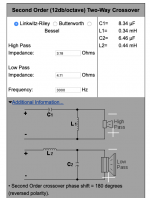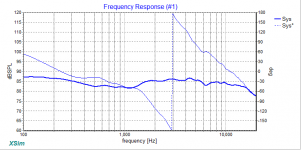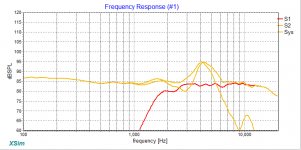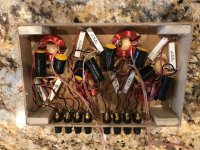I have some very basic questions for input into a 2nd order calculator (this one is on V Caps site Speaker Crossover Calculators by V-Cap )
Say my tweeter Re=3.18, would I put that into the high pass impedance (with no adjustment for the inductor?
Say my woofer Re=3.7, would I add the inductor's dc resistance of 0.41 and input 4.11 for the low pass impedance?
With the phase shift,
For the tweeter, I would wire the amp's + through the cap to the tweeter's -?
And the amp's - to the tweeter's +?
For the woofer, I would wire the amp's + through the choke to the woofer's -?
And the amp's - to the tweeter's +?
image of calculator with values and schematic attached.
Say my tweeter Re=3.18, would I put that into the high pass impedance (with no adjustment for the inductor?
Say my woofer Re=3.7, would I add the inductor's dc resistance of 0.41 and input 4.11 for the low pass impedance?
With the phase shift,
For the tweeter, I would wire the amp's + through the cap to the tweeter's -?
And the amp's - to the tweeter's +?
For the woofer, I would wire the amp's + through the choke to the woofer's -?
And the amp's - to the tweeter's +?
image of calculator with values and schematic attached.
Attachments
it is very unlikely that driver impedance at the crossover frequency will be near its dc resistance
Thank you. I didn't know that.
The tweeter shows impedance of about 3.75.
And the small woofer much higher at 11.
The tweeter shows impedance of about 3.75.
And the small woofer much higher at 11.
If you let us know the drivers we might be able to help with a better crossover than can be obtained through a calculator.
Geoff
Geoff
It is for a car stereo. I bought a used BMW 530i and needed BlueTooth, ApplePlay, etc. Got that with an Alpine head unit. Replaced the horrible factory amp (10 channel with crossovers) with an ads PQ10, so 4 x 35w. The front doors each have small 5.25" woofer, mid, and tweets. Rear door tweets and rear deck 5.25" woofers. So very restricted on speakers. Much work/cutting to get the tweeters to fit. So 2 ways ditching the 3 way front set up.
Here are the spec sheets on the speakers:
Mid/woofer
https://www.parts-express.com/pedocs/specs/290-216-dayton-audio-nd140-4-specifications.pdf
Tweeter
https://www.parts-express.com/pedocs/specs/275-108--dayton-audio-nhp25f-4-specification-sheet.pdf
I attached my next attempt figuring I'd add a 1/2 ohm in series with the tweeter (way more efficient than the woofer) and crossing high at 3.3khz. (BTW, these values land me where I wired up the tweeter, but nowhere near on the woofer.)
Thanks in advance to anyone with any thoughts.
(BTW, I only care about "fun" listening in the car, I'm obsessed enough at home so not to carry that over!)
Here are the spec sheets on the speakers:
Mid/woofer
https://www.parts-express.com/pedocs/specs/290-216-dayton-audio-nd140-4-specifications.pdf
Tweeter
https://www.parts-express.com/pedocs/specs/275-108--dayton-audio-nhp25f-4-specification-sheet.pdf
I attached my next attempt figuring I'd add a 1/2 ohm in series with the tweeter (way more efficient than the woofer) and crossing high at 3.3khz. (BTW, these values land me where I wired up the tweeter, but nowhere near on the woofer.)
Thanks in advance to anyone with any thoughts.
(BTW, I only care about "fun" listening in the car, I'm obsessed enough at home so not to carry that over!)
Attachments
I'll preface these comments with the caveats that I'm a rank beginner at this and I know bugger all about car stereos. However, I've plugged your calculated XO values into Xsim using Dayton's data (which is not measured in box) and then worked out what I think might work better.
As you can see from the Xsim (table 3) , the calculated crossover has a large peak which will likely sound poor.
I'm sure there will be better ways to do this but I thought it was worth at least doing a sim to illustrate any issues.
HTH
Geoff
As you can see from the Xsim (table 3) , the calculated crossover has a large peak which will likely sound poor.
I'm sure there will be better ways to do this but I thought it was worth at least doing a sim to illustrate any issues.
HTH
Geoff
Attachments
Ok, then this is not a problem. You are doing fine.(BTW, I only care about "fun" listening in the car, I'm obsessed enough at home so not to carry that over!)
Of course what we have been saying is that impedance cannot be defined as just one value, therefore the calculator is inherently flawed, but good enough to do what you're asking. Therefore you may want to do some experimenting and adjust your expectations accordingly. 🙂
Nice work, Geoff. That's about what I was thinking too.
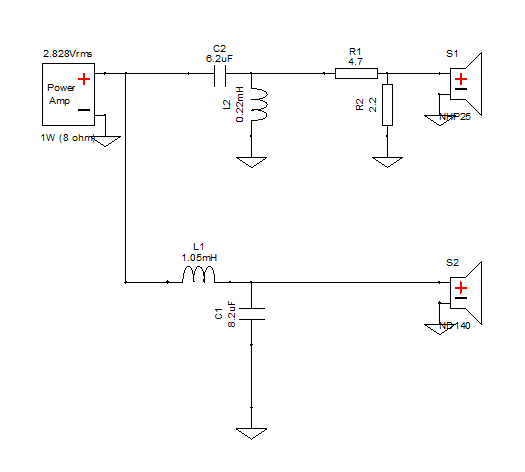
That metal breakup is a bit of a beast.
I found a couple of designs with that driver:
diVine Audio | Ochocinco
Looks like a bit of impedance correction might help get better rolloff. Dunno.
Some interesting crossover ideas here, especially at 4.50 for a 4 ohm bass.
Life S5 | Part 4: Crossover Reviews - YouTube
That metal breakup is a bit of a beast.
I found a couple of designs with that driver:
diVine Audio | Ochocinco
Looks like a bit of impedance correction might help get better rolloff. Dunno.
Some interesting crossover ideas here, especially at 4.50 for a 4 ohm bass.
Life S5 | Part 4: Crossover Reviews - YouTube
This is great! Thanks to each of you. It's nice to learn a bit about the practical aspects of this.
And putting together the xo (and ditching what I did) won't be bad at all.
Looking forward to it.
Dan
And putting together the xo (and ditching what I did) won't be bad at all.
Looking forward to it.
Dan
That metal breakup is a bit of a beast.
is that this mess at 4khz?
Attachments
So in rebuilding some 2nd order crossovers on my Snell K's and E's ages ago, it was wired amp positive to speaker positive.
But I saw on the calc from V-cap, 180 degree shift and made me think amp positive to speaker negative.
On my Snell Type 1's with 3rd order rolloff on the tweeters, I saw (I think) amp positive to speaker negative.
And here, in the suggested xo, I see amp positive to speaker positive. Which is what I expect. We are okay?
But I saw on the calc from V-cap, 180 degree shift and made me think amp positive to speaker negative.
On my Snell Type 1's with 3rd order rolloff on the tweeters, I saw (I think) amp positive to speaker negative.
And here, in the suggested xo, I see amp positive to speaker positive. Which is what I expect. We are okay?
What really matters is that firstly, the tweeter is the opposite polarity to the woofer and secondly, that both sides are the same.
However it is convention that woofers are wired for normal polarity unless there is a reason to do otherwise. It's only a formality.
However it is convention that woofers are wired for normal polarity unless there is a reason to do otherwise. It's only a formality.
The Xsim model indicates standard polarity on the tweeter, but by all means try both.
The rising raw response of the ND140 is most likely caused by the metal cone resonance; which can sound terrible; that's why it's necessary to bury it with the crossover.
Geoff
The rising raw response of the ND140 is most likely caused by the metal cone resonance; which can sound terrible; that's why it's necessary to bury it with the crossover.
Geoff
- Home
- Loudspeakers
- Multi-Way
- Basic Crossover Calculator Question
